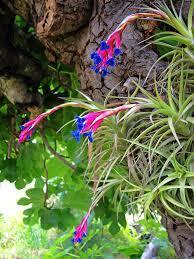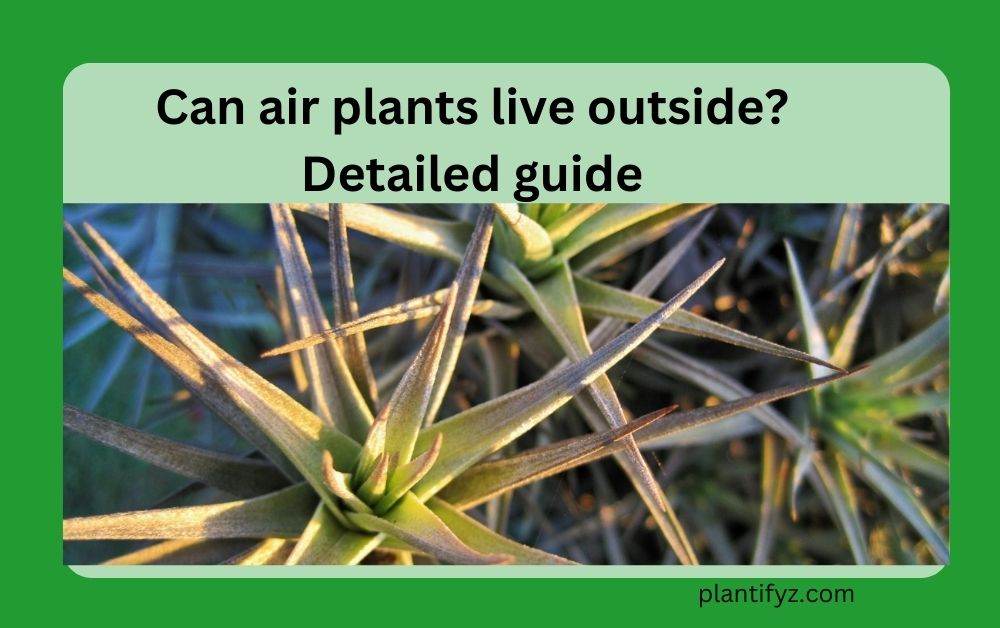Air plants, also known as Tillandsia, are truly unique and captivating in their beauty. Their epiphytic characteristic sets them to thrive without soil, drawing nutrients and moisture from the air. Tillandsia can increase your indoor beauty along with the outdoors.
Being epiphytic plants air plants can live outside in the garden on a tree. They are not difficult to grow outside as they belong there (outside; deserts, mountains, cliffs, forests; from northern Mexico to central Argentina). But there are some exceptions and requirements for growing air plants outside which you should consider for the healthy appearance of your air plants.
Be specific about air plants
Before going blindly to general care we suggest you know the species you have and their specific requirements like temperature and humidity. The general temperature for air plants is between 50°F (10°C) and 90°F (32°C) with a slight drop at night. Some species like Tillandsia ionantha, Tillandsia stricta, Tillandsia capitata need warm temperatures between 60°F to 80°F (15°C to 27°C), and species like Tillandsia tectorum, Tillandsia capitata v. domingensis can thrive in low temperature (around 50°F).
Humidity level goes same for all of the species which is 50% to 60%. There are some adaptable species such as Tillandsia bulbosa, and Tillandsia brachycaulos which can adapt to lower humidity.
That’s why you need to be specific about which kind of air plants you have. A native species can be easier to care for than a foreign species and a foreign species that is native to an environment like your environment can also give an advantage in care.
Where to place air plants outside
Choose the growing medium
The best place for placing air plants can be the crooks of tree branches as they are epiphytic and grow in tree bark which will mimic their natural habitat. Live plants will be better than dead ones but there is no problem with dead branches.
If you cannot access any of them, you can choose driftwood or rocks. You can choose a jar nice pot like, put driftwood inside it plant thilandsia and you are ready to go. Just don’t plant in traditional potting mix because air plants need enough aeration they grow depending on the air which doesn’t support potting mix or soil. [Epiphytic plant orchid can grow on potting mix]

Fix position according to light
Generally, air plants require 4 to 6 hours of light a day. This is the minimum requirement more sunlight will be better but less than that is not good.
They will need indirect sunlight meaning the light shouldn’t hit the plants directly as scorching sun can burn the leaves. As they grow on the trees they get filtered sunlight and you have to try to mimic their natural habitat environment as much as you can. Periods of direct sunlight are just fine.
You can place the plant under a big branch of a tree so that it gets shed, you can place it beside a wall or with other medium-sized plants. Do what you find best.

Care for outside air plants
Watering
Air plants totally depend on air the statement is not true. While they depend on the moisture in the air they still require watering to thrive but less than other terrestrial and epiphytic plants. The watering frequency should be once a week. Leaving for an extended period without watering can lead to death.
If you see any leaf burn or the color gets lighter, it indicates that it will need more water. Observe the water consumption behavior for the first few weeks after buying, if you see any changes adjust accordingly and keep the frequency for the lifetime. Outside, especially in hot summer may need to increase the frequency.
You can mist them if you see any dryness.
Outside air plant temperature requirement
As we know, need to keep the temperature in that (50°F (10°C) and 90°F (32°C) range. This is normal temperature for most of the region and you don’t need to worry about that. However, if the outside temperature is not in this range meaning a frost climate the temperature fluctuates too frequently you should consider bringing your air plant indoors or creating a greenhouse.
Required humidity
The humidity around air plants must be kept between 50% to 60% which is a normal humidity range for all regions and there is no reason you will need another thing like a humidifier, humidity tray, or misting. However, if the humidity is less than fifty percent then you should consider regular misting, using a humidity tray. 2 to 3 squeezes of a regular mister are enough for a day, overwatering and misting can lead to rot, eventually leading to death.
You can monitor humidity and temperature with a thermo-hygrometer.
Fertilization
Use a fertilizer that is specially made for epiphytic plants. The best choice can be orchid fertilizers. Orchid or bromeliad fertilizers are commonly used for air plants. Look for a fertilizer with a balanced ratio of nitrogen (N), phosphorus (P), and potassium (K).
Use fertilizer liquid fertilizer reducing the strength in half and mix it with water. Don’t let the fertilizer touch the plant’s leaves as it can cause burning.
Fertilizing more than once a month during the growing season is not recommended which typically spans from spring to fall. Reduce the frequency in the winter season the plants may be in a dormant or slow-growth phase.

